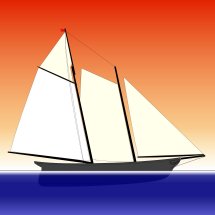Yves GARY
Hits: 7222
Category: 1871 : CHALLENGE N°2
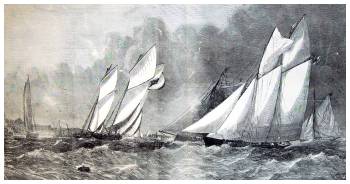 On his return to England late in the autumn, Mr. Ashbury immediately set about building a new schooner, as he had determined before he left America to make another attempt for the Cup the following year.
On his return to England late in the autumn, Mr. Ashbury immediately set about building a new schooner, as he had determined before he left America to make another attempt for the Cup the following year.
He felt, however, though he had not made a formal protest at the time, that it was unfair and not in accordance with the terms under which the Cup was held... to require him to sail against the whole New York Yacht Club fleet, and he entered at once into negotiations with the club to decide this, and some other points at issue, before the next race.
The end of races against a whole fleet
The first question in dispute was whether or not the New York Yacht Club would make him sail against a whole fleet as before. This, he contended, was wholly against the letter and intent of the deed, which distinctly called for a "match" race. If, however, the New York Yacht Club still insisted on its previous interpretation, he declared he would then get as many yacht clubs as possible in Great Britain to challenge, each naming his new vessel, the Livonia as its representative, and with this authority he would claim the right to race the New York Yacht Club fleet in one race for each club that he represented; and any race which he might win should entitle him to the Cup for the club which he happened to represent in that particular race.
This fanciful little plan was blocked by the New York Yacht Club finally submitting, in the spring of 1871, its position in the matter to Mr. George L. Schuyler, the then sole surviving member of the original syndicate which presented the Cup to the club. Many yachtsmen on both sides of the water felt that the club's position was untenable; that it was asking a challenger to sail under conditions which were condemned as unfair and unsportsmanlike by the owners of America when they won the Cup, and that the meaning of the word " match " as applied to yacht racing was a race between two boats.
Hence Mr. Schuyler's letter to the club giving his views on this disputed point was gratifying to these fair-minded yachtsmen. It was as follows:
I

think any candid person will admit that when the owners of the America sat down to write their letter of gift to the New York Yacht Club, they could hardly be expected to dwell upon an elaborate definition of their interpretation of the word ' match,' as distinguished from a ' sweep-stakes ' or a regatta ; nor would he think it very likely that any contestant for the Cup, upon conditions named by them, should be subjected to a trial such as they themselves had considered unfair and unsportsmanlike. ...
“It seems to me that the present ruling of the club renders the Americas trophy useless as a * Challenge Cup,' and that for all sporting purposes it might as well be laid aside as family plate. I cannot conceive of any yachtsman giving six months' notice that he will cross the ocean for the sole purpose of entering into an almost hopeless contest for the Cup, when a challenge for love or money to meet any one yacht of the New York Yacht Squadron in any fair race would give him as great a triumph, if successful, or if his challenge were not accepted, as his heart could desire. If the ownership of the Americas Cup depended upon the result it would add greatly to the interest of the match; but the absence of that inducement would scarcely compensate for the .long odds of sailing against the whole fleet....
"When the word 'match' is used in horseracing or kindred sports without any qualification, it means a contest between two parties — and two only. If A offers to run his horse against B's horse for $1000, and this offer is accepted, it is a ' match ' ; but if C desires to participate by entering his horse and by putting up his thousand dollars, the match becomes a * sweepstakes.'
“The same rule applies to yachts. The Vesta and Fleetwing made a match for a large sum to sail across the Atlantic. When the Henrietta was admitted into the contest it became * a sweepstakes.' "
 The New York Yacht Club accepted, somewhat reluctantly, this interpretation, but though it conceded the point it still reserved the right to meet the challenger with any yacht it pleased in any of the races sailed, picking four yachts and only naming its representative on the morning of the race. Thus, while only matching one boat in each race against the challenger, it could pick out on the morning of the race a light weather or a heavy weather boat, as conditions warranted, or in case of accident could substitute any one of the four it saw fit.
The New York Yacht Club accepted, somewhat reluctantly, this interpretation, but though it conceded the point it still reserved the right to meet the challenger with any yacht it pleased in any of the races sailed, picking four yachts and only naming its representative on the morning of the race. Thus, while only matching one boat in each race against the challenger, it could pick out on the morning of the race a light weather or a heavy weather boat, as conditions warranted, or in case of accident could substitute any one of the four it saw fit.
While agreeing to these terms, Mr. Ashbury still had two more points he wanted settled. He desired the Americans to meet him with a keel boat of somewhat the same type as his new vessel, as he contended it would be unfair to race a light displacement, centerboard yacht against a sea-going keel schooner. This the New York Yacht Club would not agree to, reserving the right to race with any type of boat it chose, and Mr. Ashbury finally accepted their ruling on the point. As a matter of fact. the New York club named as its representatives for the race two centerboard and two keel schooners.
Choice of courses and number of races
The other point at issue was the selection of the course. The challenger objected to the New York Yacht Club inside course, claiming that it was an unfair course for a foreign yacht, as knowledge of local conditions played an important part in sailing it. He asked for a series of races outside Sandy Hook, free from headlands. This point was finally compromised by alternating the courses between the regular New York Yacht Club course (the inside one) and one of twenty miles to windward and return outside Sandy Hook lightship.
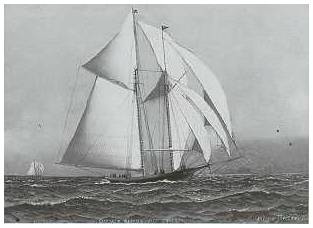 At this stage of the negotiation the date had advanced to May, and it was then too late to give the required six months' notice of a challenge if a race was to be sailed in 1871. So on May 27, Mr. Ashbury asked the club if it would waive the six months' clause and give him a race in October, as Livonia could leave England September 1st. This the New York Yacht Club agreed to do, and preparations were made to race in that month.
At this stage of the negotiation the date had advanced to May, and it was then too late to give the required six months' notice of a challenge if a race was to be sailed in 1871. So on May 27, Mr. Ashbury asked the club if it would waive the six months' clause and give him a race in October, as Livonia could leave England September 1st. This the New York Yacht Club agreed to do, and preparations were made to race in that month.
The waiving of the six months' notice did not at all settle the pen and ink contest, however, for on June 15th Mr. Ashbury wrote asking for a series of twelve races, and sending certificates of representation from twelve English yacht clubs naming his new boat as the challenger. The New York Yacht Club agreed to meet him in twelve races, but only to recognize the challenge of one of the clubs named, the Royal Harwich Yacht Club.
On Mr. Ashbury's arrival here negotiations were again resumed and became acrimonious before all the details were finally settled. At one time it looked as if the race would fall through entirely, Mr. Ashbury still maintaining his right, under the strict terms of the deed, to sail a race for each of the clubs which he represented, and if he won any race to claim the Cup for that particular club. Finally it was agreed to sail a series of seven races, alternating the courses between the inside one and one off the Hook, the winner of four to take the Cup, only the Royal Harwich Yacht Club being recognized, the first race to start October 16th.

 AMERICA'S CUP
AMERICA'S CUP![]()



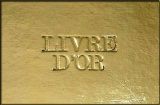

 think any candid person will admit that when the owners of the America sat down to write their letter of gift to the New York Yacht Club, they could hardly be expected to dwell upon an elaborate definition of their interpretation of the word ' match,' as distinguished from a ' sweep-stakes ' or a regatta ; nor would he think it very likely that any contestant for the Cup, upon conditions named by them, should be subjected to a trial such as they themselves had considered unfair and unsportsmanlike. ...
think any candid person will admit that when the owners of the America sat down to write their letter of gift to the New York Yacht Club, they could hardly be expected to dwell upon an elaborate definition of their interpretation of the word ' match,' as distinguished from a ' sweep-stakes ' or a regatta ; nor would he think it very likely that any contestant for the Cup, upon conditions named by them, should be subjected to a trial such as they themselves had considered unfair and unsportsmanlike. ...
 The New York Yacht Club accepted, somewhat reluctantly, this interpretation, but though it conceded the point it still reserved the right to meet the challenger with any yacht it pleased in any of the races sailed, picking four yachts and only naming its representative on the morning of the race. Thus, while only matching one boat in each race against the challenger, it could pick out on the morning of the race a light weather or a heavy weather boat, as conditions warranted, or in case of accident could substitute any one of the four it saw fit.
The New York Yacht Club accepted, somewhat reluctantly, this interpretation, but though it conceded the point it still reserved the right to meet the challenger with any yacht it pleased in any of the races sailed, picking four yachts and only naming its representative on the morning of the race. Thus, while only matching one boat in each race against the challenger, it could pick out on the morning of the race a light weather or a heavy weather boat, as conditions warranted, or in case of accident could substitute any one of the four it saw fit.




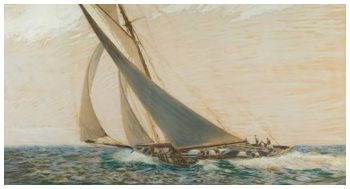
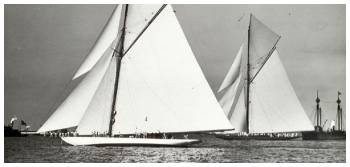
 Oct. 5, 1901
Oct. 5, 1901


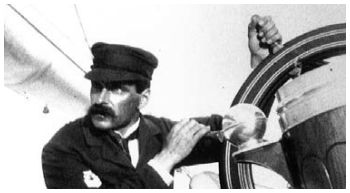 Who is this genius?
Who is this genius?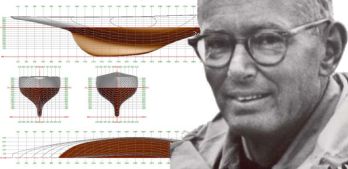 Olin J. Stephens was born on April 13, 1908 in the Bronx, New York. His father was a coal merchant who moved the family to Scarsdale, New York in 1913, where Olin and his brother Rod went to school. It was while spending summers on the New England coast that Olin first learned to sail.
Olin J. Stephens was born on April 13, 1908 in the Bronx, New York. His father was a coal merchant who moved the family to Scarsdale, New York in 1913, where Olin and his brother Rod went to school. It was while spending summers on the New England coast that Olin first learned to sail.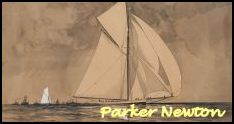 A painter, illustrator and writer, Parker Newton was born in New York and lived and worked in the environs of Toronto, Canada; New York City; and the state of Connecticut. He died in Neuilly, France (a Paris suburb) on May 13, 1928.
A painter, illustrator and writer, Parker Newton was born in New York and lived and worked in the environs of Toronto, Canada; New York City; and the state of Connecticut. He died in Neuilly, France (a Paris suburb) on May 13, 1928.

